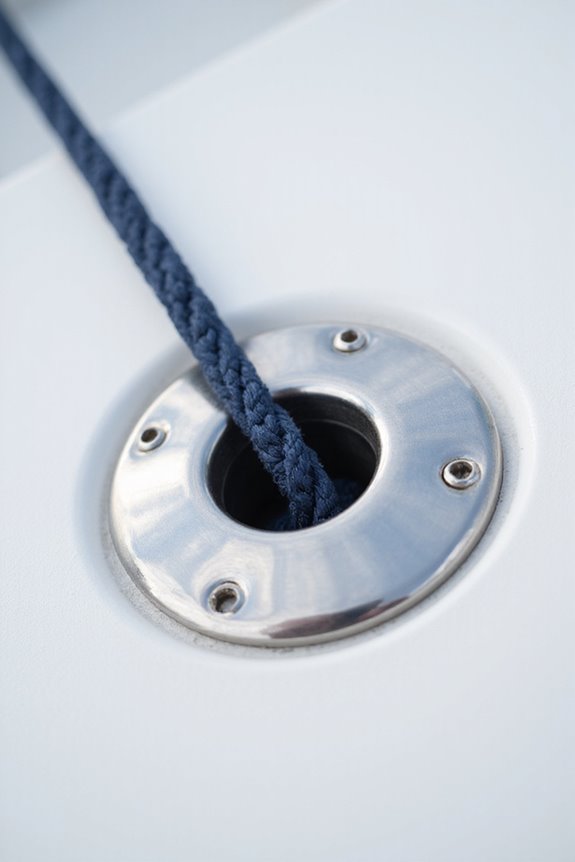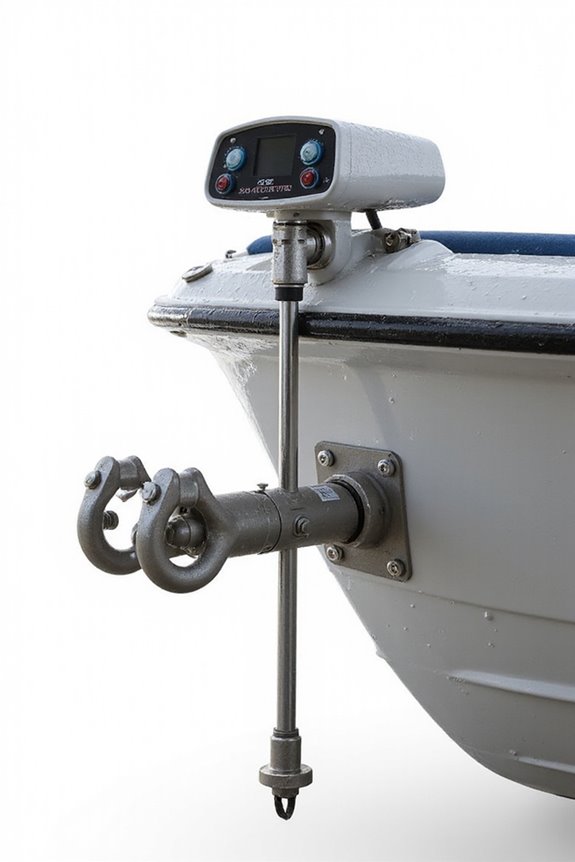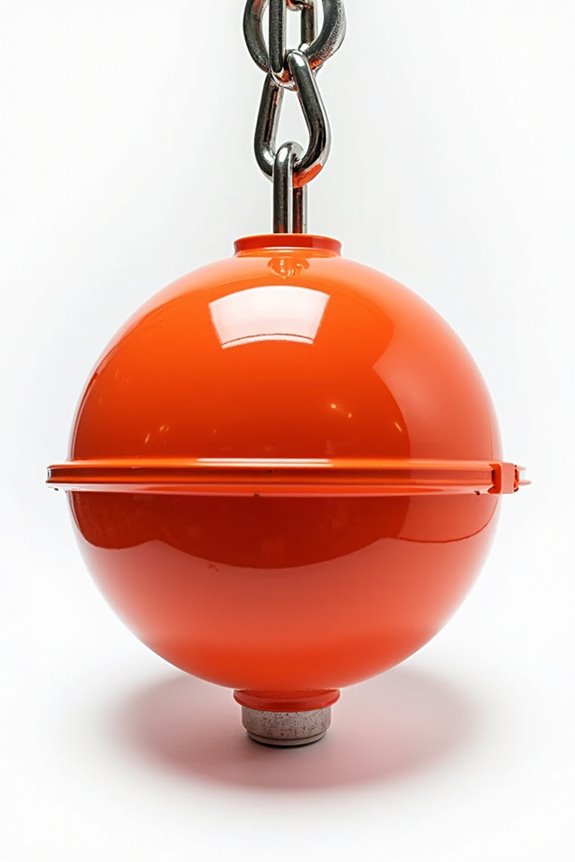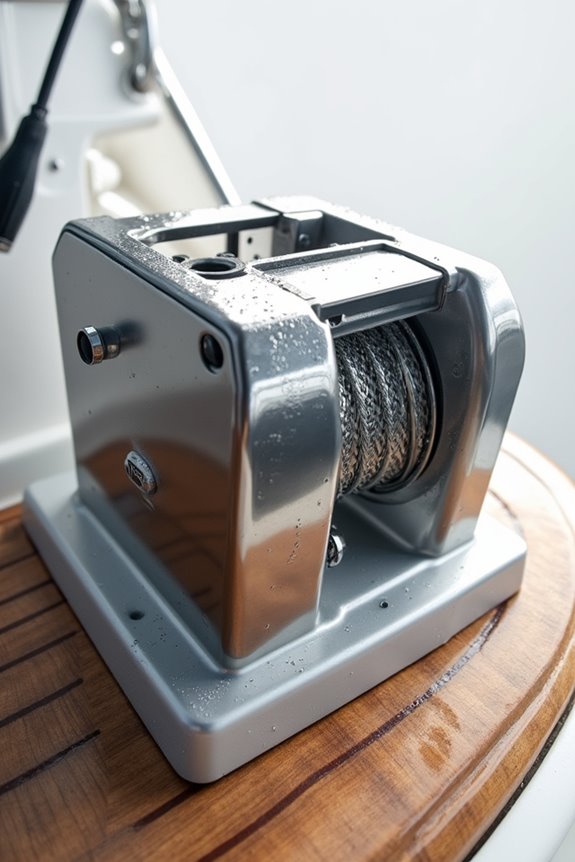Ever struggled with tangled ropes on deck? Fairleads are our go-to solution, guiding lines smoothly to prevent chafing and knotty messes. They come in various types—like roller or cam fairleads—each designed to keep ropes running cleanly at different angles. Made from materials like stainless steel or nylon, they’re built tough for marine life. Fairleads aren’t just old-school gear; they’re key players in safe, efficient sailing. Curious about installing and maintaining them? Stick around for more insights.
Key Takeaways
- Fairleads guide ropes smoothly, reducing friction and preventing chafing during boating operations.
- Various types like bullseye, roller, and cam fairleads serve specific rope management needs on boats.
- Constructed from materials like stainless steel, aluminum, and composites for durability and corrosion resistance.
- Proper installation and regular maintenance ensure fairlead reliability and prolong rope and equipment life.
- Fairleads enhance safe, efficient sail handling by controlling rope direction and minimizing tangles.
What Are Fairleads and How Do They Work?
Let’s talk fairleads—a small but mighty part of your boat’s setup that you might not think about until things get tangled or ropes start wearing out. Fairleads are clever fittings guiding our ropes and lines, essential in fairlead mechanics for smooth rope management. They control angles, reducing friction and preventing chafing, which keeps lines lasting longer and sailing safer. Whether it’s a bullseye or a roller fairlead, each directs lines so they glide neatly instead of rubbing harshly against the boat’s surfaces. Think of them as rope traffic controllers, ensuring everything moves without a hitch, avoiding frustrating snarls. So, embracing fairleads isn’t just about hardware—they’re key teammates helping us handle sails efficiently and keeping our boating experience enjoyable and trouble-free.
Historical Significance of Fairleads in Sailing
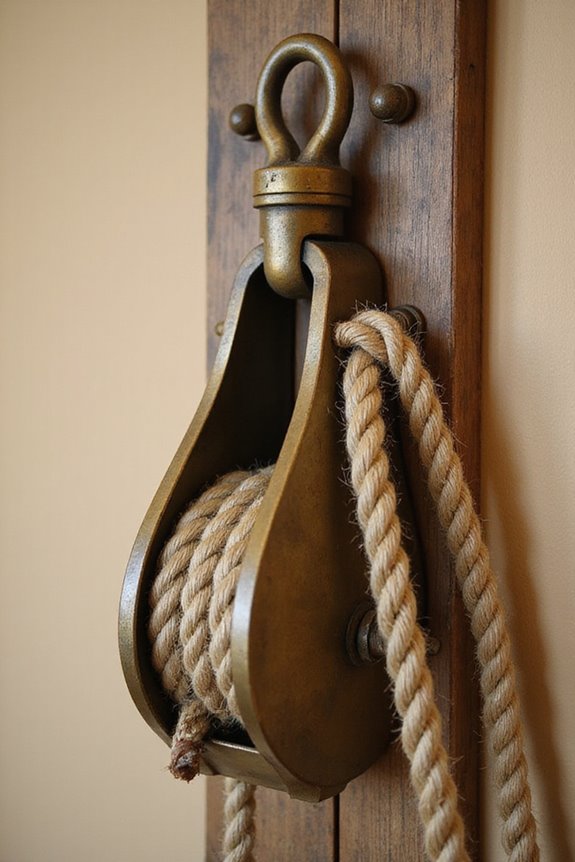
After getting a good sense of how fairleads work on our boats today, it’s interesting to see how these humble fittings have shaped sailing over the centuries. The historical evolution of fairleads reflects their significant role in maritime practices, guiding ropes smoothly and reducing wear long before modern materials existed. Early sailors relied on wooden fairleads—simple yet sturdy—to manage lines efficiently, which was critical for safety and performance. Can you imagine handling rigging without them? Over time, fairleads adapted, incorporating metal and synthetic materials as technology advanced, showing continuous improvement. They weren’t just practical; fairleads facilitated the shift from square rigs to lateen sails, changing how vessels moved and managed sail power. Knowing this history helps us appreciate fairleads as more than just fittings—they’re a legacy of smart, essential seamanship.
Different Types of Fairleads and Their Uses
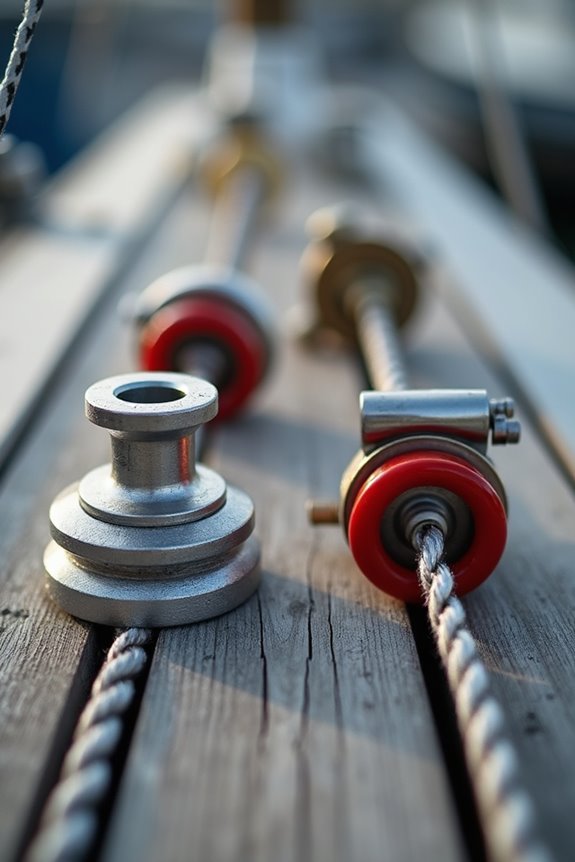
While fairleads might seem like simple hardware at first glance, they actually come in a variety of types, each designed to handle specific tasks on our boats. Take deck fairleads—they keep halyards and sheets neatly guided on flat surfaces, preventing line tangles. Then there are stanchion fairleads, mounted on railings to keep lines off the deck, which helps avoid clutter and wear. Cam fairleads cleverly combine line gripping and guiding functions, perfect for quick adjustments without needing extra cleats. We also rely on roller fairleads to reduce friction on ropes, saving them from chafing during mooring. And don’t forget straight fairleads, which keep lines moving smoothly along a fixed path, along with handed fairleads, tailored for bow or stern to guard ropes from sharp edges. Handy, right?
Common Materials Used in Fairlead Construction
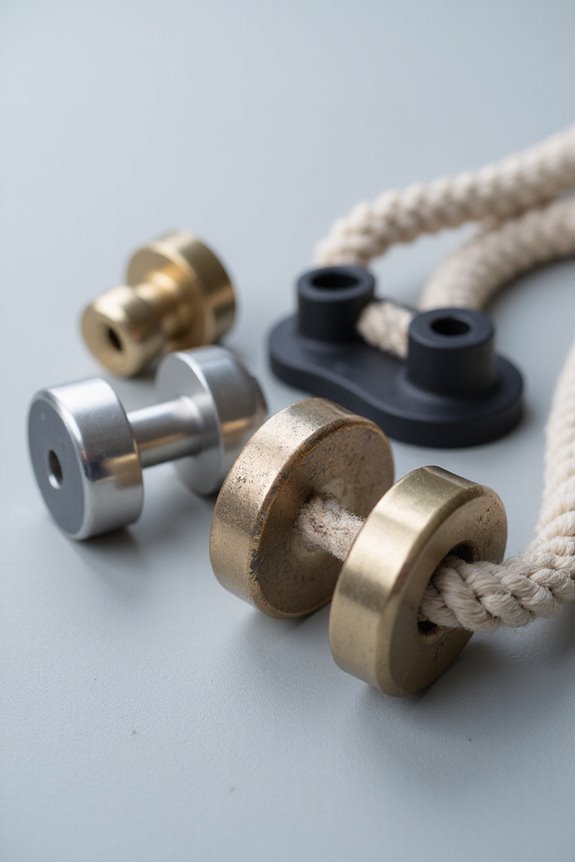
When it comes to fairleads, the material they’re made from isn’t just about looks—it can make a big difference in performance and longevity. Fairlead materials range from stainless steel, prized for its corrosion resistance and durability, to lightweight aluminum, perfect for smaller boats. Ever considered nylon or composite materials? They’re great for reducing friction and resisting chemicals, which means less wear and tear on your lines. Construction techniques often combine these materials to balance strength, weight, and maintenance needs. Titanium alloys, though pricier, offer impressive strength-to-weight ratios for those of us tackling tougher conditions. So, whether you’re gearing up for a leisurely sail or something more intense, selecting the right material guarantees your fairlead works smoothly and lasts longer. After all, a well-chosen fairlead is like a quiet crew member—you might not notice it, but you definitely appreciate its reliability!
The Role of Fairleads in Modern Boating and Marine Operations
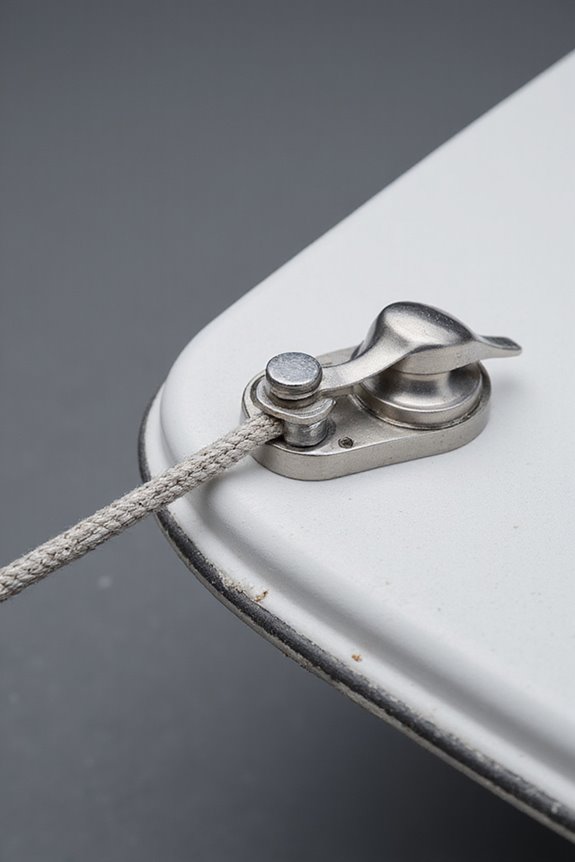
Since fairleads might seem like small, unassuming pieces of hardware, you might not realize just how essential they are in modern boating and marine operations. Fairlead applications stretch from mooring lines on fishing vessels to heavy-duty towing and offshore oil rigs. They guide ropes and cables, preventing wear and ensuring smooth, safe handling—even in rough seas or high tension. Ever wonder how a huge anchor line doesn’t chafe on sharp edges? That’s fairleads doing their job. Thanks to fairlead innovations like corrosion-resistant materials and roller designs, they’re now tougher and more efficient than ever. So, whether we’re pulling a boat alongside a dock or handling complex offshore operations, fairleads help us keep everything aligned and performing safely. Pretty impressive for a little piece of gear, right?
Benefits of Using Fairleads on Your Vessel
Although fairleads might seem like small and simple pieces of gear, they actually bring a bunch of benefits to your vessel that can make a big difference during your time on the water. First off, fairleads help maintain perfect line alignment, which stops ropes from tangling and guarantees smoother operations whether you’re docking or towing. Ever tried wrestling with a snarled line? Yeah, no fun. Plus, they play an essential role in friction reduction, protecting both your ropes and the boat’s fittings from wear and tear. This means less maintenance—and who doesn’t love that? Beyond saving gear, fairleads make handling lines safer and more controlled, reducing risks of accidents. So, why settle for chaos when a simple guide can keep your lines tidy and your sailing smoother?
Proper Installation Techniques for Fairleads
Fairleads do more than just keep your lines tidy—they perform best when installed correctly, and that’s where a bit of know-how really pays off. First, we have to examine fairlead placement carefully. Putting them in the right spot isn’t just about aesthetics; it guarantees smooth line handling and prevents annoying chafing. Then there’s fairlead alignment—getting this spot on avoids unnecessary wear on your ropes and hardware. Using sturdy bolts or screws that match your fairlead’s material helps keep everything secure under pressure. Don’t forget load distribution; your mounting should spread stress evenly to avoid failures when the boat’s working hard. And if you want some flexibility, opting for track-mounted fairleads offers adjustable placement so you can tweak things as wind conditions change. Who said installing a little metal guide can’t be fun?
Maintenance Tips to Ensure Fairlead Longevity
A solid maintenance routine is like a fairlead’s best friend—without it, you’re asking for trouble down the line. We all know that regular fairlead inspection is key to spotting wear, loose bolts, or corrosion before they become real problems. It’s smart to focus on the spots where ropes enter and exit, since those areas take the most abuse. Ever tried untangling a rusty, squeaky roller? Not fun. That’s where proper lubrication techniques come in. Using the right marine-grade lubricant keeps rollers and bearings spinning smoothly and extends their life. Don’t forget to clean off salt and grime regularly—that’s the simple secret to preventing frustrating corrosion. Keeping records of inspections and maintenance helps us stay ahead, ensuring our fairleads perform safely, season after season.
Frequently Asked Questions
Can Fairleads Be Customized for Unique Boat Designs?
Ever wonder if your boat deserves something special? We understand custom fairlead designs perfectly match unique boat specifications, letting us create precise, durable solutions that fit your vessel’s personality—because we’re all part of the same sailing family.
How Do Fairleads Affect Rope Tension During Heavy Loads?
When heavy loads strain our ropes, fairleads keep rope alignment precise and guarantee even load distribution. Together, we reduce tension spikes and wear, making our boating experience safer and more connected through reliable, smooth operations.
Are There Specific Fairleads Recommended for Saltwater vs. Freshwater Use?
We recommend fairleads made from corrosion-resistant materials for saltwater use to fight saltwater corrosion, while freshwater fairleads prioritize durability with lighter metals. Together, we’ll choose gear that perfectly suits your boating environment.
What Are the Cost Differences Between Various Fairlead Materials?
Imagine choosing a fairlead is like picking a trusty shield: stainless steel costs more but offers unmatched durability, aluminum balances cost and weight, and plastic’s budget-friendly charm suits lighter tasks. Together, we weigh cost comparison and material durability wisely.
Can Fairleads Be Safely Used With Synthetic Ropes?
It is understood that synthetic compatibility matters, so we choose hawse fairleads to reduce rope friction and fiber wear. Together, we guarantee safe, smooth winching by avoiding sharp edges and embracing fairleads designed specifically for synthetic ropes.

